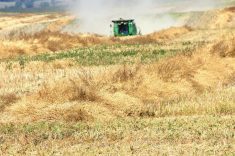Wheat futures prices received a bullish bump after the release of the United States Department of Agriculture’s Small Grains 2022 summary report.
The USDA is forecasting 1.65 billion bushels of total wheat production, down from its August estimate of 1.783 billion bu.
Todd Hultman, lead market analyst with DTN, believes the lower production number is due to the USDA slashing its harvested acreage estimate by two million acres.
Read Also

Alberta researcher helps unlock the economics of farming
Lethbridge Polytechnic researcher helping agriculture producers with decision-making tools in economic feasibility
“I’d have to assume that’s related to the drought conditions this year, and it could also have been related to some of the early planting problems,” he said.
Hultman was most taken aback by the new spring wheat production forecast of 482 million bu., which was well below the average trade estimate of 514 million bu.
“We’ve been hearing from guys in the northern states that they really liked the looks of their spring wheat this year,” he said.
“A lot of them were very happy with the yields.”
He acknowledged that he hasn’t spoken to many growers in Montana, where it was drier than it was in North Dakota and Minnesota.
Hultman said pasta producers will not be pleased with the new durum forecast of 64 million bu., which was below the trade estimate of 74 million bu.
Wheat futures prices shot up anywhere between 16 and 25 cents per bu., in the Chicago, Kansas City and Minneapolis exchanges.
“I’ve been waiting quite a while for a rebound in wheat,” said Hultman.
“I’ve been bullish on wheat ever since we had the $5 drop and I just felt like the market has been unfairly sold.”
He said wheat prices have been depressed mainly due to reports calling for 100 million tonnes of production in Russia. But it is unclear if those estimates include parts of Ukraine.
Hultman also noted that Russian President Vladimir Putin is starting to make threats about ending the agreement that opened a grain shipping corridor for Ukraine.
If that happens there would likely be a backlash against Russian exports from foreign banks, insurance companies and shipping lines.
Arlan Suderman, chief commodities economist with StoneX, said he is worried about a shortage of feed grains in the U.S.
“Today’s USDA report tightens wheat stocks that are going to be needed to be fed in the Plains feedlot belt,” he said during a webinar.
He estimated there is already a 700 million bu. deficit of corn and sorghum.
“In some of these big feedlot states we’re also tight on wheat supplies,” said Suderman.
For instance, Kansas has 306 million bu. of wheat stocks as of September 2022, which is 100 million bu. below last year’s levels.
Suderman said the USDA’s new hard red winter wheat forecast is 531 million bu., again well below the trade estimate of 573 million bu.
“It’s the smallest since, I believe, 1957,” he said.
“That’s a small crop.”
And the new winter wheat crop is off to an inauspicious start.
Maps show there is still significant drought west of the Mississippi River where much of the hard red winter wheat crop is grown. Drought is improving in Texas but getting worse in Kansas and Oklahoma.
When Suderman plugs the new USDA estimates into his 2022-23 supply and demand balance sheet it generates an ending stocks number of 467 million bu., well below last year’s 660 million bu.
Suderman also noted that two-thirds of Argentina’s wheat crop is “parched” and crop ratings are well below normal in that country.
Contact sean.pratt@producer.com
















